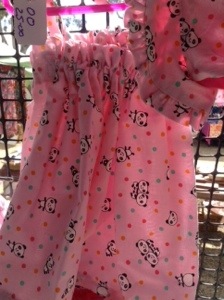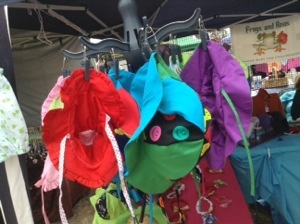Ma and I are old hat with these December markets. We’re totally onto our third one. Which is actually a big thing and loudly tells all who understand a market stall that we are suckered in now. There is no turning back.
You can tell the dedication of a marketter, or maybe their experience, at two key times of the year.
Are they there in the middle of July in minus degrees, and are their views in the December market the same as the previous November one. Essentially, wouldn’t it be sweet if we sold something today?
December markets attract a lot of new stalls. I know, November was when we started. And we started with the same attitude of the new stall owners. Oh yay! We’re going to sell everything because people have totally told us we make cool things.
Erm. No. Yes, you probably do make good things. I see a lot of good and sometimes some really awesome stuff. But I also see a lot of the same mistakes for first timers.
I’m not saying this from a ranty view point. I’m saying it because they were the same mistakes we made two and a bit years ago, and it has taken many, many stalls to start working out how to break even.
So, how to make it work?
Easy.
1. Understand that you are not going to make a lot of money. If you are making handmade items, you will never be able to charge for the time it took you to make an item. Unless you charge yourself in cents per hour. Decimal cents in some cases. This will likely never be your day job. The market stalls that make money are resellers (those who buy up big on Ebay and sell the products), or food sellers (though, not really) and plants, I think, they seem to sell a lot. Some handmade market stalls can make a lot of money, it does happen, but it’s unlikely to happen on your first stall. A lot of people who make money with “handmade” stuff, started out that way and then ship their designs off overseas and get them to make their product on mass (which then starts the debate of what is a resell and what is handmade). So try to lower your expectations, otherwise you might have a really bad first time, which leads into;
2. Building a market takes time. If you are charging more than $10 for an item, people like to think. They like to think lots. They like to go away and ponder. This usually means going right away, back to their homes, and pondering until the next market. Or the market after that. Or the one after that, or a whole damn year of pondering, which I have seen. What Ma and I found was having cheap little items under $10, such as our hats, got people in. They bought something small, and then months afterwards they plod back into our stall and they’re the ones that buy the $35 items. And then you develop regulars, and then people who have been referred. It’s taken us two years, but we now have two regulars. They don’t come every market, but when they do, they buy something – or they order something. Our marketting neighbours have more than that, because they’ve been there way longer than us.
What this means is that you need to be there at the markets before the key December ones. If they’re monthly markets, October and November are a must. If they are weekly, I’d start at a minimum halfway through November. I saw a new December marketter selling beautiful product for $200 plus, beautiful re-purposed furniture. They sold nothing. You can sell items at my market that are worth that much, but rarely on the first go. If they don’t lose their nerve and keep coming, they might attract a few sales, but it will take time. Especially as this is a monthly market.
3. Diversify your product. My market, you can make the big sales. The metal worker near to us, (I have bought the most awesome robot from him, “8-C-O”) sells items well over $200, sometimes $300. Ma and I started off with $30-$40 quilts the first time, and that was all we had. We sold enough to make the money back from the cost of the market, but not much else. I think we only sold two quilts. We spent our time watching the stall next to us, and watching the nature of shoppers. Shoppers like a lot of things to browse, they like to think about big tickets items, but if they like your work, they’ll happily purchase the cheaper items while they think. The metal workers and artists who walk out with cash on hand, are the ones that have staggered pricing. The big pieces which stay for stall after stall (and eventually sell) and the small works from under $20 and $10, which they have on mass. Ma and I have cheap headbands, hats, and baby slippers. We sell more hats, (sometimes only hats) than we do our cardigans and clothing sets.
4. Know your market. I wanted to make fascinators and clutches. Baby clothes and cardigans were what we settled on, and that came about because Ma and I had a frank discussion about where our strengths lay, and how much time it takes to make an outfit versus a clutch. That, and our market attracts a lot of parents and babies and grandparents. That being said, we could have done anything, people will buy anything if the price is right. We sit between a stall that paints decorative masks and a stall that sells wood turned pens and clocks, and they both do very well. The point is more that whatever you decide to do, theme your whole store around it. If you want to do dog clothes, do everything to do with dogs. Collars, treats, beds, you can even stray into the other pet territory. When you try to do something outside that area, say, headbands for small children, shoppers won’t look, won’t know they’re there, or think they have something to do with dogs, which leads to slightly odd conversations.
So that’s it. My four steps to maybe having a good market. Sounds a bit daunting, but I find if you have these things in your head when you start, it gives you a better idea about how to approach what you’re doing, and maybe making some sales to help fuel your habit. Mine is the buying of wool. I run market stalls so I can buy pretty wool and knit cute things for kids I don’t know. And that is awesome.
As to other things. Our December stall is done. Made some good sales this time around, made up for a poor November. (No one buys in November, they just look and then come back for the Chrissie gifts in December.) So I’ll leave you with some photos. The panda and frog fabric I bought from Japan, and a shot of what I bought with my share of the profits this time. Yes, I am a cruel owner.







That fabric is just too adorable!!!
I know that I’m that kind of shopper at a market – I tend to buy smaller items at around $10 – $20 (usually pickles or jams, or cute things that can make good gifts) and you’re totally right about circling back later to buy a bigger ticket item – or even at a later market.
I like it when the stall owners also have a business card that links to an etsy (or similar) site, because I don’t always carry more than $50 in cash with me and it’s always 2 days later when you suddenly have regrets for not buying that super cute thing at the time – kekeke
We have this one lady who shows up at 830 (markets don’t officially open until 10) looks through all our stuff, disappears. At 9-930, she’ll resurface and buy something. She’s hanging out for winter so she has an excuse to buy a cardi. I imagine her with a huge flock of grand kids all with various items of our clothing. She so lovely.
But yeah, most people are the same. Anything $20 or over takes serious thought. Especially our cardis. And you see the same people every market crooning over the same item, and then finally they might buy it, like 6 months later. Or a year.
I don’t mind it, because that’s how I shop. So can’t exactly get grumpy at people for doing the same thing I do.
We’re hoping to have an Etsy store with stuff on it soon. I’m just lazy! But we do get orders from people when we hand out business cards, which always surprises me.
Also, I need to go back to Japan. I need more fabric!! The frog material is all sold out now! If only I had had a bigger suitcase!
Santa Gambit! Or Gambit Claws? Ah, I could keep going but I won’t because I’m good that way.
I can’t believe this is your third Christmas market! No, actually, I refuse to believe it. How can you have been going that long? Surely you only started a couple of months ago.
We buy food at markets, especially fancy-pants stuff, and we generally forget to bring any sort of cooler bag in which to transport it back home. And Tim always complains we didn’t bring enough cash but that’s deliberate, because I know we’ll spend it all. Why must people make so many delicious cheeses and infused olive oils? It’s cruel, I tell you.
I totally fail at replying to comments. Mostly because I thought I had, only it turns out it was in my head…
I know, we’re in our third year of this. Ma and I had a serious talk about whether we’d be giving it up… Turns out we’re addicts who’d miss it too much.
Also, you should have seen option 2 for Gambit. I was fully after the reindeer suit first, complete with hoodie with antlers. Except it was made of really thick polyester, and the poor pup would overheat. I am such a terrible owner. I think there’s some rule book out there which says no to dressing up butch staffys. But he’s so cute! And by cute I mean ridiculous.